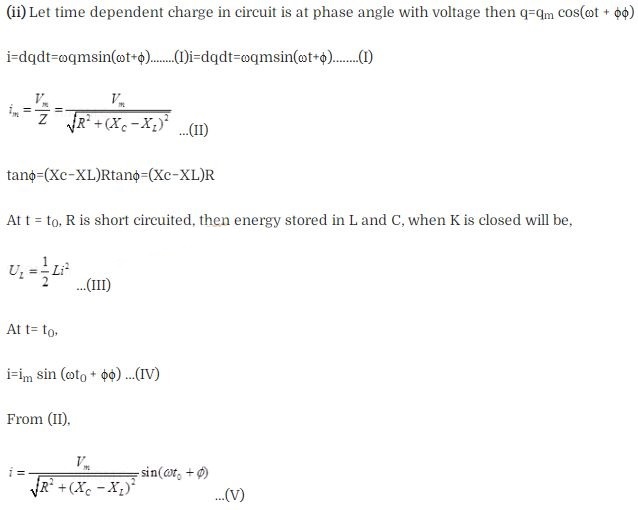Alternating Current
Class 12th Physics NCERT Exemplar Solution
Multiple Choice Questions (MCQs)
Single Correct
Answer Type
Question 1. If the rms current in a 50 Hz AC circuit is 5 A, the
value of the current 1/300 s after its value becomes zero is
Solution: (b)
Key
concept: Equation for i and V: Alternating current or voltage varying
as sine function can be written as

Question 2. An alternating current generator has an internal
resistance Rgand an internal reactance Xg It is used to
supply power to a passive load consisting of a resistance Rg and a
reactance XL. For maximum power to be delivered from the generator to
the load, the value of XL is equal to
(a) zero
(b) Xg
(c) -Xg (d)
Rg
Solution: (c) For maximum power to
be delivered from the generator (or internal reactance Xg) to the
load (of reactance, XL),
=> XL + Xg
= 0 (the total reactance must vanish)
=>XL=-Xg
Question 3.
Solution:
Question 4. To reduce the resonant frequency in an L-C-R series
circuit with a generator,
(a) the generator frequency
should be reduced
(b) another capacitor should be added in
parallel to the first
(c) the iron core of the inductor
should be removed
(d) dielectric in the capacitor should be
removed
Solution: (b)

Question 5. Which of the following combinations should be selected
for better tuning of an L-C-R circuit used for
communication?
(a) R = 20 Ω, L = 1.5 H, C =
35μF
(b) R = 25 Ω, L = 2.5 H, C = 45
μF
(c) R=15Ω, L = 3.5H, C = 30 μF
(d)
R = 25 Ω, L = 1.5 H, C = 45 μF
Solution:
(c)

where R is the resistance, L is the inductance and C is the
capacitance of the circuit.
For high Q factor R should be low, L should be
high and C should be low. These conditions are best satisfied by the values
given in option (c).
Important point: Be careful while writing formula for
quality factor, this formula we used in this case is only for series L-C-R
circuit.
Question 6. An inductor of reactance 1 Ω and a resistor of 2 Ω are
connected in series to the terminals of a 6 V (rms) AC source. The power
dissipated in the circuit is
(a) 8 W (b) 12
W
(c) 14.4 W (d) 18 W
Solution: (c) According to the problem, XL = 1 Ω , R = 2 Ω ,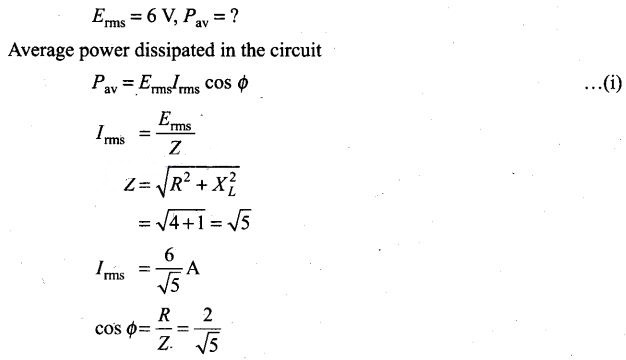

Question 7. The output of a step-down transformer is measured to be
24 V when connected to a 12 W light bulb. The value of the peak current
is
Solution: (a)
One or More Than One Correct Answer Type
Question
8. As the frequency of an AC circuit increases, the current first increases and
then decreases. What combination of circuit elements is most likely to comprise
the circuit?
(a) Inductor and capacitor (b) Resistor and
inductor
(c) Resistor and capacitor (d) Resistor, inductor
and capacitor
Solution: (a, d) Compare the given
circuit by predicting the variation in their reactances with frequency. So, that
then we can decide the elements.
Reactance of an inductor of inductance L is
XL = 2πvL, where v is the frequency of the AC circuit.
Question 9. In an alternating current circuit consisting of
elements in series, the current increases on increasing the frequency of supply.
Which of the following elements are likely to constitute the
circuit?
(a) Only resistor (b) Resistor and an
inductor
(c) Resistor and a capacitor (d) Only a
capacitor
Solution: (c, d) This is the similar
problem as we discussed above. In this problem, the current increases on
increasing the frequency of supply. Hence, the reactance of the circuit must be
decreased as increase in frequency. So, one element that must be connected is
capacitor. We can also connect a resistor in series.
For a capacitive
circuit,
XC = 1/ωC =1/2πfC
When frequency increases,
XC decreases. Hence current in the circuit increases.
Question 10. Electrical energy is transmitted over large distances at
high alternating voltages. Which of the following statements is (are)
correct?
(a) For a given power level, there is a lower
current
(b) Lower current implies less power
loss
(c) Transmission lines can be made
thinner
(d) It is easy to reduce the voltage at the
receiving end using step-down transformers
Solution: (a, b, d)

Question 11. For an L-C-R circuit, the power transferred from the
driving source to the driven oscillator is P = I2 Z cos
Ф.
(a) Here, the power factor cos Ф > 0, P >
0
(b) The driving force can give no energy to the
oscillator (P = 0) in some cases
(c) The driving force
cannot syphon out (P < 0) the energy out of oscillator
(d) The driving force can take away energy out of the
oscillator
Solution:
Question 12. When an AC voltage of 220 V is applied to the capacitor
C
(a) the maximum voltage between plates is 220
V
(b) the current is in phase with the applied
voltage
(c) the charge on the plates is in phase with the
applied voltage
(d) the power delivered to the capacitor is
zero
Solution: (c, d) If the alternating voltage
is applied to the capacitor, the plate connected to the positive terminal of the
source will be at higher potential and the plate connected to the negative
terminal of source will be at lower potential. So the plates capacitor is
charged.
Question 13.
Solution:
Very Short Answer Type Questions
Question 14. If
an L-C circuit is considered analogous to a harmonically oscillating spring-
block system, which energy of the L-C circuit would be analogous to potential
energy and which one analogous to kinetic energy?
Solution: When a charged capacitor C having an initial charge q0 is
discharged through an inductance L, the charge and current in the circuit start
oscillating simple harmonically. If the resistance of the circuit is zero, no
energy is dissipated as heat. We also assume an idealized situation in which
energy is not radiated away from the circuit. The total energy associated with
the circuit is constant.
The oscillation of the LC circuit are an
electromagnetic analog to the mechanical oscillation of a block-spring
system.
The total energy of the system remains conserved.


Question 15. Draw the effective equivalent circuit of the circuit
shown in figure, at very high frequencies and find the effective
impedance.
Solution:
Key concept:
The element with infinite resistance will be considered as open circuit and the
element with zero resistance will be considered as short circuited.
Question 16. Study the circuits (a) and (b) shown in figure and
answer the following questions.
(a) Under which conditions would the rms currents in
the two circuits be the same?
(b) Can the rms current in
circuit (b) be larger than that in (a)?
Solution:

Question 17. Can the instantaneous power output of an AC source ever
be negative? Can the average power output be negative?
Solution:
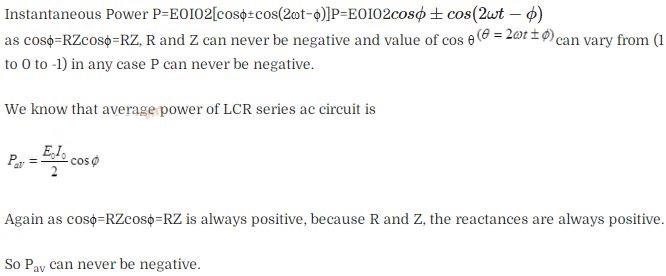
Question 18. In a series LCR circuit, the plot of Imax
versus co is shown in figure. Find the bandwidth and mark in the
figure.
Solution:
Question 19. The alternating current in a circuit is described by the
graph shown in figure. Show rms current in this graph.
Solution:
Question 20. How does the sign of the phase angle Ф, by which the
supply voltage leads the current in an L-C-R series circuit, change as the
supply frequency is gradually increased from very low to very high
values?
Solution:
Short Answer Type Questions
Question 21. A device
‘X is connected to an AC source. The variation of voltage, current and power in
one complete cycle is shown in figure.
(a) Which curve
shows power consumption over a full cycle?
(b) What is the
average power consumption over a cycle?
(c) Identify the
device X.
Solution: (a) Power is the product of
voltage and current (Power = P = VI).
So, the curve of power will be having
maximum amplitude, equals to the product of amplitudes of voltage (V) and
current (I) curve. Frequencies , of B and C are-equal, therefore they represent
V and I curves. So, the curve A represents power.
(b) The full cycle of the
graph (as shown by shaded area in the diagram) consists of one positive and one
negative symmetrical area.
Hence, average power consumption over a cycle is zero.
(c)
Here phase difference between V and I is π /2 therefore, the device ‘X’ may be
an inductor (L) or capacitor (C) or the series combination of L and C.
Question 22. Both alternating current and direct current are measured
in amperes. But how is the ampere defined for an alternating
current?
Solution: For a Direct Current (DC),
1
ampere = 1 coulomb/sec
Direction of AC changes with the frequency of source
with the source frequency and the attractive force would average to zero. Thus,
the AC ampere must be defined in terms of some property that is independent of
the direction of current. Joule’s heating effect is such property and hence it
is used to define rms value of AC.
So, r.m.s. value of AC is equal to that
value of DC, which when passed through a resistance for a given time will
produce the same amount of heat as produced by the alternating current when
passed through the same resistance for same time.
Question 23. A coil of 0.01 H inductance and 1 ω resistance is
connected to 200 V, 50 Hz AC supply. Find the impedance of the circuit and time
lag between maximum alternating voltage and current.
Solution:
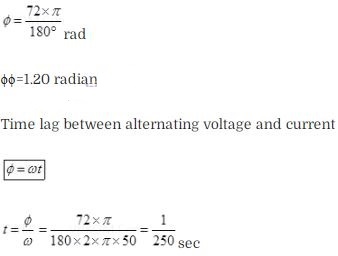
Question 24. A 60 W load is connected to the secondary of a
transformer whose primary draws line voltage. If a current of 0.54 A flows in
the load, what is the current in the primary coil? Comment on the type of
transformer being used.
Solution:

Question 25. Explain why the reactance provided by a capacitor to an
alternating current decreases with increasing frequency.
Solution: Capacitor plates get charged and discharged when an AC
voltage is applied across the plates. So the current through capacitor is as a
result of charging charge. Because the frequency of the capacitive circuit
increases, the polarities of the charged plates change more rapidly with time,
giving rise to a’larger current. The capacitance reactance (XC) due
to a capacitor C varies
as the inverse of the frequency (f) (as
XC=1/2π fC) and hence approaches zero as v approaches infinity. The
current is zero in a DC capacitive circuit, which corresponds to zero
proportional and infinite reactance. Also, Since XC is inversely
proportional to frequency, capacitors tend to pass high-frequency current and to
block low-frequency currents and DC (just the opposite of inductors).
Question 26. Explain why the reactance offered by an inductor
increases with increasing frequency of an alternating
voltage.
Solution: The inductive reactance is
given by XL = 2πfL, XL is proportional to the frequency
and current is inversely proportional to the reactance. An inductor opposes the
flow of current through it by developing a back emf according to Lenz’s law. If
the current is decreasing, the polarity of the induced emf will be so as to
increase the current and vice-versa.
Since, the induced emf is proportional
to the rate of change of current.
Long Answer Type Questions
Question
27.
Solution:


Question 28.
Solution:


Question 29. Consider the L-C-R circuit shown in figure. Find the net
current i and the phase of i. Show that i = V/Z. Find the-impedance Z for this
circuit.
Solution: Key concept: In the circuit given
above consists of a capacitor (C) and an inductor (L) connected in series and
the combination is connected in parallel with a resistance R. Due to this
combination there is an oscillation of electromagnetic energy.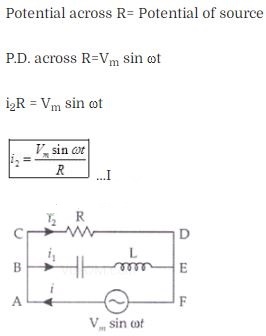





Question 30.
Solution: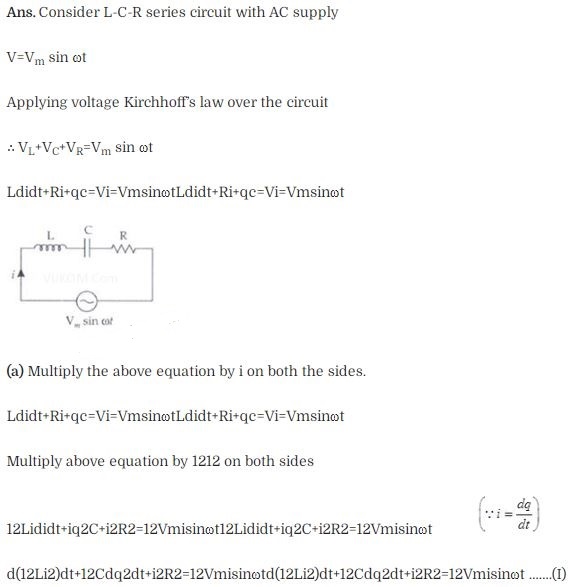
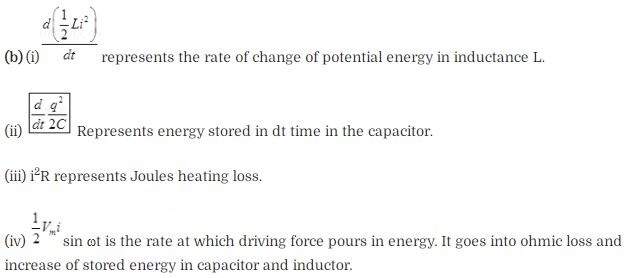

Question 31.

Solution:![]()

